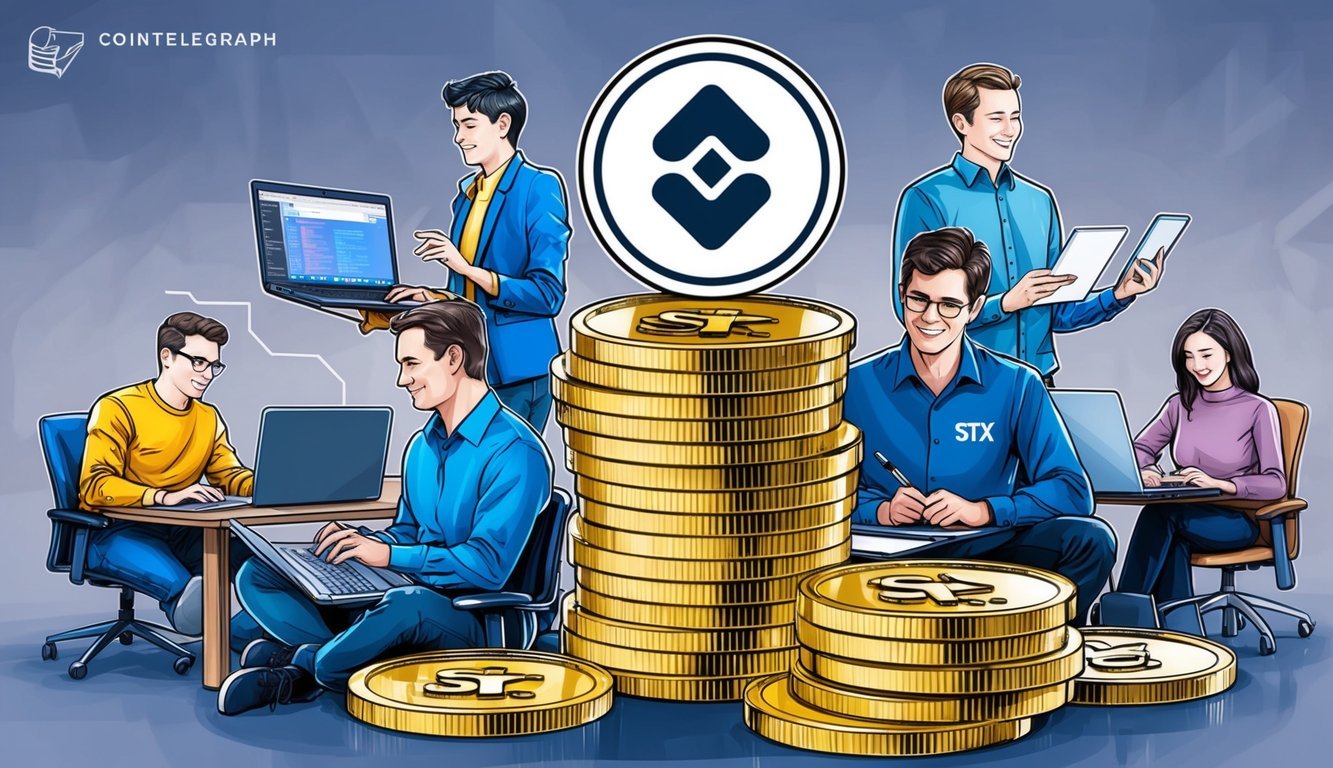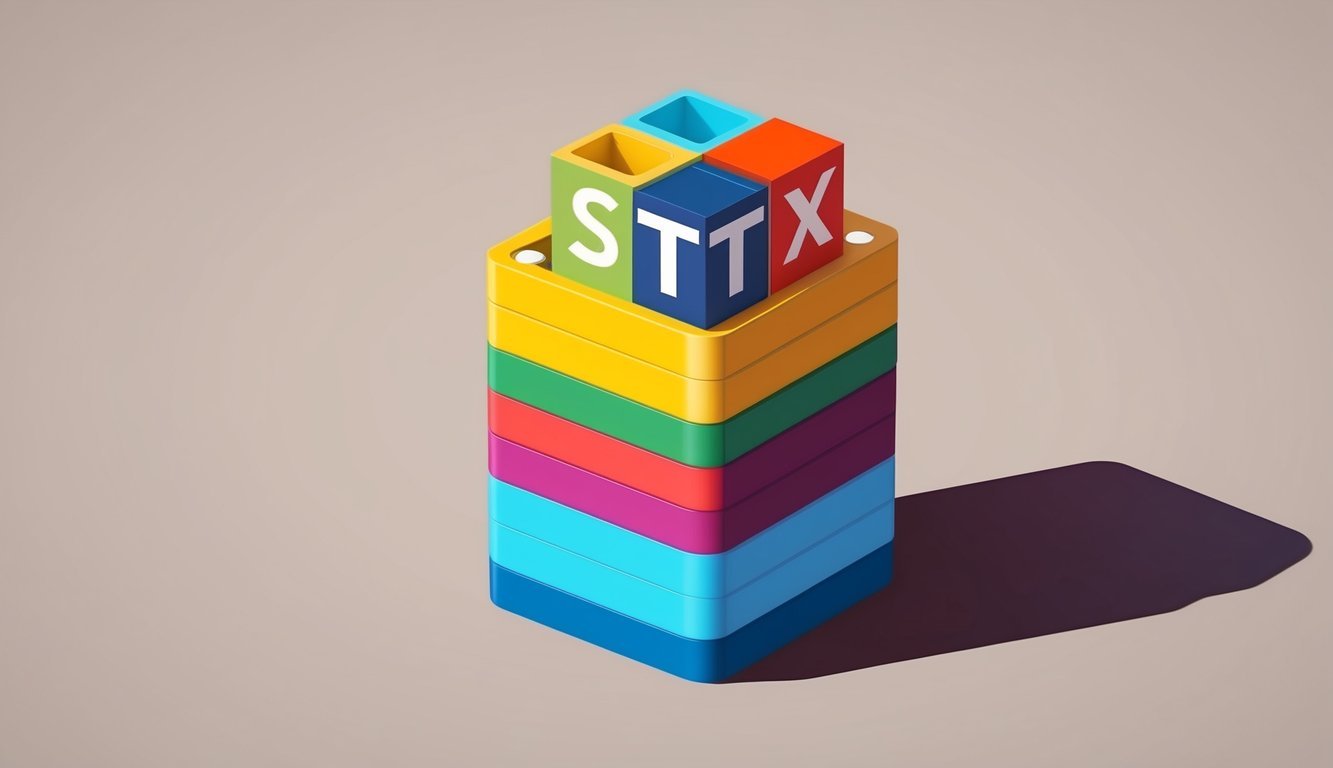Stacks is a blockchain platform that aims to bring smart contracts and decentralized apps to Bitcoin. It’s designed to work alongside Bitcoin, not replace it. The Stacks token (STX) is the native cryptocurrency of the Stacks network. You can use STX for fueling smart contracts, rewarding miners, and earning Bitcoin.

You might be wondering why Stacks is unique. Well, it’s one of the few platforms that tries to enhance Bitcoin’s capabilities without changing its core protocol. This means you can enjoy the security of Bitcoin while also accessing more advanced blockchain features.
If you’re into crypto, you’ve probably heard about the limited programmability of Bitcoin. Stacks aims to solve this by enabling developers to create apps and smart contracts that are secured by Bitcoin’s network. It’s like giving Bitcoin superpowers without messing with its core strength.
Key Takeaways
- Stacks brings smart contracts to Bitcoin without changing Bitcoin’s core protocol
- STX tokens power the Stacks network and can help you earn Bitcoin
- You can use Stacks to access decentralized apps secured by Bitcoin’s network
Understanding Stacks
Stacks is a blockchain platform that brings smart contracts and decentralized apps to Bitcoin. It uses a unique approach to leverage Bitcoin’s security while enabling new functionality.
Technology and Consensus Mechanism
Stacks uses a consensus mechanism called Proof of Transfer (PoX). This system links Stacks to Bitcoin’s security. Here’s how it works:
- Miners on Stacks spend Bitcoin to mine STX tokens.
- This process secures the Stacks blockchain and provides Bitcoin holders with STX rewards.
PoX allows Stacks to benefit from Bitcoin’s strong security without changing Bitcoin itself. You can think of Stacks as a layer that sits on top of Bitcoin, adding new features.
The Role of Clarity Language
Stacks uses a programming language called Clarity for smart contracts. Clarity is designed to be:
- Predictable and easy to analyze
- Secure by default
- Compatible with Bitcoin’s design principles
With Clarity, you can write smart contracts that interact with Bitcoin in interesting ways. For example, you could create an app that uses Bitcoin as collateral.
Interoperability with Bitcoin
Stacks is all about working with Bitcoin, not competing against it. Here’s how they connect:
- Stacks records its block headers on the Bitcoin blockchain.
- This lets Stacks tap into Bitcoin’s security and finality.
- You can use Bitcoin in Stacks apps and smart contracts.
This setup means you get the best of both worlds. You have Bitcoin’s rock-solid security plus the flexibility of smart contracts and apps. It’s like supercharging Bitcoin without changing its core rules.
STX Token Economics
STX is the native token of the Stacks network. It plays a key role in the network’s economy and consensus mechanism.
Token Utility and Stacking
STX tokens have several important uses. You can use them to pay for transactions and smart contract execution on the Stacks network. One cool feature is stacking, where you lock up your STX to earn Bitcoin rewards.
When you stack STX, you’re helping secure the network. It’s like getting paid to be a virtual security guard. The more STX you stack, the more Bitcoin you can potentially earn.
Developers also need STX to deploy their apps on Stacks. This creates demand for the token as the ecosystem grows.
Market Cap and Trading Volume
STX has seen some interesting price action. As of November 2024, its market cap is over $2.3 billion, making it a top 50 cryptocurrency.
The 24-hour trading volume often exceeds $60 million. This shows there’s a lot of interest and activity around STX.
You can trade STX on major exchanges like Binance, Coinbase, and KuCoin. This wide availability makes it easy for you to buy or sell STX if you want to.
CoinGecko is a great place to check STX’s current price and historical data. The token hit its all-time high back in 2021, but prices can be volatile in crypto.
Ecosystem and Applications
Stacks has a growing ecosystem with many exciting projects. You can find decentralized apps, DeFi platforms, and NFT marketplaces built on Stacks. These use Bitcoin’s security while adding new features.
Decentralized Applications (DApps)
DApps on Stacks let you do cool stuff with Bitcoin. You can use apps for storing data, gaming, and social media. These work like regular apps but don’t have a central company controlling them.
Some popular DApps include:
- Hiro Wallet: Manage your STX and Bitcoin
- ALEX: Trade crypto and earn rewards
- Gamma: Buy and sell NFTs
New DApps are always popping up. Developers like Stacks because it’s easy to build on and connects to Bitcoin.
Stacks and DeFi Integration
DeFi on Stacks is growing fast. You can now do lots of financial stuff without banks:
- Lend and borrow crypto
- Trade tokens
- Earn interest on your STX
Some projects are even making Bitcoin-backed stablecoins. This could be huge for bringing Bitcoin into DeFi.
Big exchanges like Binance support STX trading. This makes it easy to get started with Stacks DeFi.
NFTs and Community Growth
NFTs are booming on Stacks. You can buy, sell, and create unique digital items. Some cool NFT projects include:
- Bitcoin Monkeys
- Megapont Ape Club
- This is #1
NFTs help grow the Stacks community. Artists and collectors come together around these projects.
There are also grants for builders. You can earn STX for coding and growing the ecosystem. This brings in new talent and ideas.
Earning and Participating

Stacks offers ways to earn Bitcoin and play a role in the network. You can get BTC rewards by locking up STX tokens or help secure the blockchain as a miner.
Earning Bitcoin Through Stacking
You can earn Bitcoin by locking your STX tokens in a process called Stacking. This lets you get BTC rewards for supporting the network.
To start Stacking, you need to lock up your STX for a set time. The more STX you lock, the more Bitcoin you can earn. You can Stack on your own or join a pool with others.
Stacking is part of Stacks’ Proof of Transfer (PoX) system. It links Stacks to Bitcoin and lets STX holders get BTC rewards. You could earn up to 10% per year in Bitcoin by Stacking.
Role of Miners and Signers
Miners and Signers play key parts in keeping the Stacks network running smoothly.
Miners create new blocks on Stacks by spending Bitcoin. They get new STX tokens as a reward. This process, called Nakamoto release, adds new STX to the supply over time.
Signers work with Stackers to check and sign blocks. They help make sure the network stays secure and transactions go through correctly.
Together, miners and Signers keep Stacks linked to Bitcoin. They make it possible for you to use smart contracts and apps while tapping into Bitcoin’s security.
Frequently Asked Questions

Stacks (STX) has many practical uses and important features to understand. Let’s look at some common questions about using STX, wallets, pricing, mining, and recent developments. One of the notable aspects of Stacks is its ability to integrate with existing blockchain ecosystems, including its compatibility with the Polygon Matic Ethereum scaling solution, which enhances transaction speeds and reduces costs. This synergy allows developers to build decentralized applications more efficiently, leveraging the strengths of multiple platforms for greater reliability and performance. Furthermore, recent developments in the Stacks ecosystem promise to expand its capabilities, making it an increasingly attractive option for developers and users alike.
How can I use Stacks (STX) in my daily transactions?
You can use STX for smart contracts and decentralized apps on the Bitcoin blockchain. It lets you access DeFi services and NFTs built on Bitcoin.
You might pay fees for these services with STX. Some stores also accept STX as payment, but it’s not widely used for everyday purchases yet.
What kind of wallet should I get for Stacks (STX)?
You should get a wallet that supports the Stacks blockchain. The Xverse wallet is a popular choice for STX.
It’s available as a browser extension and mobile app. Other options include the Hiro Wallet and hardware wallets like Ledger.
How is the price of Stacks (STX) determined?
STX price is set by supply and demand on crypto exchanges. Factors that affect it include:
- Bitcoin’s price movements
- New Stacks projects and partnerships
- Overall crypto market trends
- STX staking and mining activity
Trading volume and market sentiment also play a role in short-term price changes.
Could you explain how Stacks (STX) mining works?
Stacks mining is unique. It uses a process called Proof of Transfer (PoX) that links to Bitcoin.
Miners commit Bitcoin to earn newly minted STX and transaction fees. This helps secure the Stacks network while also anchoring it to Bitcoin’s security.
Is Stacks (STX) available on Coinbase for trading?
Yes, you can trade STX on Coinbase. It’s available on many major crypto exchanges.
Other platforms that list STX include Binance, KuCoin, and OKX. Always check current listings as exchange offerings can change.
What’s the latest news about Stacks (STX) coin?
Recent Stacks news includes new DeFi projects and Bitcoin NFT platforms. The team is working on improving scalability and smart contract features.
Keep an eye on the official Stacks social media and crypto news sites for the most up-to-date info. The STX ecosystem is growing, with more apps and services being built regularly.




